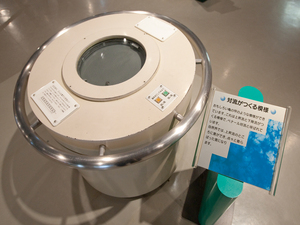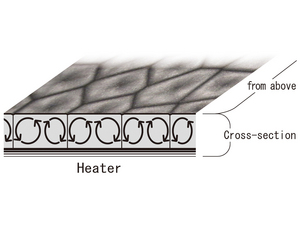Nagoya City Science Museum
TOP > Exhibition Guide > Keyword Search > Starting with "P" > pattern > Benard convection
Benard convection



Purpose of Exhibition
The exhibit is a flattish container, holding silicone oil and aluminum powder, with its bottom heated by a heater and at the same time its top cooled by a cooler. Keep looking down at the container and, through the movements of the aluminum powder, you will see the silicone oil heated at the bottom of the container rising by convection and then sinking after being cooled at the top of the container. This convection is called "Rayleigh-Benard Convection." Variations in convection are available, including a streaky convection by blowing air onto the surface of the silicone oil in the container. Besides, another variation in convection is observable by stirring the silicone oil.
Additional Knowledge
Just watch the container. Keep looking down on the container and you will see the container's content divide into cells with a diameter of several centimeters. Take a good look at those cells and you will see the silicone oil coming up from the bottom of the container to gush out in the central area of the surface and then sinking from around the cells toward the bottom.
The flat bottom of the container allows the heater to evenly heat the silicone oil. Convection occurs when the silicone oil becomes lighter from heating. But at that time, it floats at some portions and sinks down at some portions for unknown reason. Consequently, the cells are viewable at the point of sinking down as shown in the picture. Those cells never stay stable long in physical properties. If you watch the cells for a long while, you will find them to change in shape and/or size.
This intriguing convection phenomenon is named “Rayleigh-Benard Convection” after the two researchers ‐ Rayleigh and Benard ‐ or just “Benard Convection.”Routinely, “Benard Convection” occurs in the clouds in the sky. When the rays of the sun heat the earth's surface, the heated surface heats the air immediately above it, thus making the air lighter than the upper air. At that point, convection occurs. But even above the surface of the ocean where a wide range of air is evenly heated, the air ascends at some portions and descends at some portions. Where the air ascends, clouds are formed in the sky. Undoubtedly, the clouds are present in the sky, just like the cells seen in the exhibit as a demonstration of "Benard Convection." This phenomenon occurs in the Sea of Japan as well during winter. When you come across telecast images of Meteorological Satellite "Himawari" ("Sunflower"), have a careful look at them.
Article by Tetsuro Ojio, curator
